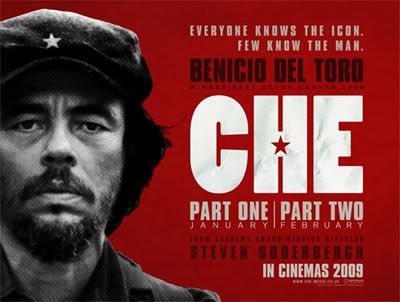On Che

It was interesting to see Che parts 1 & 2, a (subdivided) film about something political, having recently seen Hunger and Waltz With Bashir, both of which are political films. While all three dramatise real and very divisive political moments, the latter two go to some lengths to circumvent bias, employing narrative devices to cut through the potential partisanship of their tellings. They bring us (in this reviewer's opinion, astonishingly successfully) up close with the blood and guts of these human situations. It is as though for Steve McQueen and Ari Folman, the writers and directors of Hunger and Waltz With Bashir respectively, the I.R.A hunger strike of 1981 and the I.D.F activities in Lebanon of around the same time were attractive exactly because of the difficulties of approaching subjects whose violent, forlorn realities are cordoned off, as it were, by the layers of highly emoted opinion surrounding them. Steven Soderbergh in Che parts 1 & 2 is, in contrast, concerned with presenting Ernesto ‘Che’ Guevara as hero and the US as imperialist, puppet dictator-sponsoring baddie, full stop. Thence the Indians vs Cowboys, Rocky vs Apollo, David vs Goliath drama of the piece.
The strapline on the UK poster - Everyone knows the icon, few know the man - is wholly misleading. Che is throughout presented, in part 1 during the successful Cuban uprising/ revolution of 1959, in part 2 in the abortive Bolivian version eight years later, administering to the sick, rallying troops, scolding his troops when they thieve or rape, enlightening campesinos. That is, he is presented exactly as an icon; his human touch moments only serve to heighten his iconicity; he is untroubled by any moments of conscience that might lead us to believe in or identify with him; he is always decisive. If Soderbergh had wanted to delve into Guevara the man, he would perhaps have picked the period in between 59 and 67 (part 3, anyone?), and the (still, of course, ongoing) struggles to institutionalize La Revolución - but here we have an action movie, make no mistake. Apart from when the camera angle is the point of view of Che when he is finally gunned down and we see through his eyes, so to speak - confirming the project as one of identifying us with hero Che – and very interesting, primitive even, in relation to the major narrative contortions that Hunger and Waltz With Bashir go through to situate the viewer in relation to protagonists and events - very little attempt is made to get inside the mind. Action movies function through ciphers. The cutting room floor is the only place for the psychological, immediate, 'being there'-feeling revelations if they do not fit the obviously what-happens-next trajectory. Y punto. Soderbergh is nothing if not au fait with filmic conventions.
Che parts 1 & 2 has tension, rip-roaring moments, beautiful shots (I especially liked the scenics of the Andean lowlands which show Bolivia for the bigger, moister Wales it is), some understated technical brilliance (as we have come to expect from Soderbergh when he dons his cinematographer hat), and much humour (even aside from an odd, half-hammy, half-wooden cameo from Matt Damon). But, especially in part 2, which drifts and drifts, there is a sense that Del Toro is still yet to find a film equal to his (truly heroic) abilities.



No comments:
Post a Comment